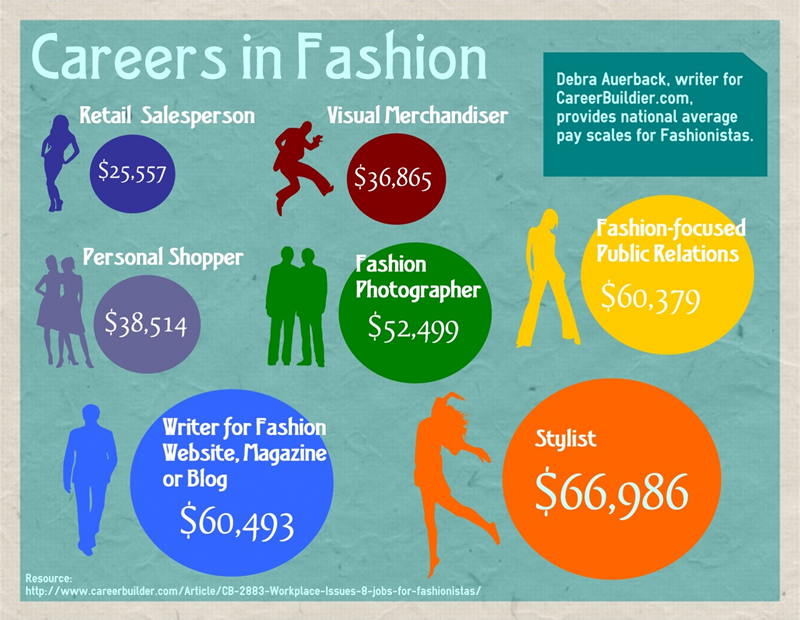If you dream of becoming the next Donna Karan or Versace, it is time to turn that dream into a reality. Becoming a fashion designer isn’t easy, but it can be done- as long as you’re committed and willing to put in the work. Drawing up designs is just a fraction of what it takes: you need technical expertise, fashion knowledge, real-life experience, and determination, to go from nobody to somebody.
There are so many avenues to pursue, finding the right path for you can be tricky. This article will help you figure it all out. It outlines the steps necessary to succeed as a fashion designer, from building your portfolio and finding trade shows to fashion schools and creating prototypes. Just be sure to remember us when your famous!
Fashion Design 101: The Basics

Having a passion for clothes and a talent to envision and create them is just the beginning when it comes to fashion design. You have to know where your strengths lie, figure out what you want to create and decide where and how you intend to do it. And you have to understand that everything you intend to do takes time.
Overnight success is not what this industry is about. Establishing your name and brand means long hours, lots of rejection and years of living paycheck to paycheck. But if you stick with it, eventually you will find your niche and you will feel pride seeing others wear what you dreamt up.
So what does it take to become a designer? Here are the basics, which we will explain in the upcoming sections:
- Learn the trade and hone your skills
- Develop a plan/strategy
- Develop your trade at school
- Learn about business
- Complete a portfolio
- Intern for a company/ply your trade
Learning the Trade: From Concept to Prototype

Being able to dream up different concepts, whether it be dresses or designer socks, is great, but not if you can’t create them. You need to be able to draw what you see, making it a 3-D image on paper not just on paper, but on the computer and on the actual materials. You also need basic sewing skills to put your design together once you come up with and draw out the patterns.
Striking drawings and computer animations won’t get you far. Yes, you can at some point get into a company and have others make what you draw, but you first need to get your foot in the door. That means showing companies actual pieces, which means you need to sew them yourself.
Besides, working with fabrics, understanding how they move, drape and conform to the body, is a key component for creating realistic and innovative designs that will work on people, not mannequins. That’s why the first thing you need to do is familiarize yourself with the tools of the industry. Here’s how:
- Invest in drawing materials, from charcoal pencils to colored oils, to help design the exact shades, tones and textures you want.
- Use Software programs such as Adobe Acrobat, or Optitex Pattern Making Suite, to create on the computer. These programs are invaluable for helping you tweak your designs and play around with variations of something you have in mind.
- Take a basic sewing class to learn simple patterns and stitching, so you can make a mock-up of your drawings.
- Study the industry and learn the current trends; studying other designers will train your eye to pick up fine details, differentiate between styles and give you a sense of what direction you want to go in. Sign up for
Develop Your Plan

Knowing you love fashion is not enough: you need to know what it is you love about fashion and turn it into moving, functioning designs. In the beginning you may want to make everything, but as you begin to learn and practice you will need to harness your talent and focus on a certain segment of the industry.
There are major areas of design to consider, such as haute couture, leisurewear, and business wear, as well as sub-categories, like women’s every day or children’s fitness wear. Each of these areas have their own advantages and disadvantages, so you will want to read up on each, as well as seek advice from other designers.
For instance, haute couture is a potentially lucrative area that can turn high profits and get you world-wide recognition. However, it is a very exclusive area and requires a high level of innovative and unique design collections- on a consistent basis. In other words, it is not an area to go into if you are not sure.
The best thing you can do is experiment with a few styles that interest you in a few categories and see where your talents lie. Then decide if your passion lies there too. Knowing which direction you are going will allow you to fine tune your skills and dramatically improve your work. It also makes for a more polished and professional looking portfolio. Here are the main factors to consider when choosing a field:
- Know your abilities: if you are someone with a more classic vision then stick to formal wear or an area that plays to your strengths. You may love edgy, cutting-edge fashion, but if you can’t see it in your mind’s eye you cannot create it.
- Know your location: if you live in Alaska and plan to stay there, a bikini line will probably not do well. Understand the climate and customer needs. You want your line to cater to the market you’re in.
- Consider your limits: are you willing to move to reach a different market? Do you mind working on strict deadlines? Knowing what you will and won’t do can help eliminate areas that don’t fit your personality. If you are laid back and casual, a fashion house that does pressure-filled shows may not work.
Attend Design School

While a degree is not required to be a fashion designer, in my opinion it is the single best thing you can do to make your career a long and lasting one. Before we explain what schools and programs to attend, let’s look at how school will help you.
To start, some employers and fashion houses prefer it, so having one increases your job opportunities. You don’t want to miss put on a job or internship because you lack a degree. Besides, honing your craft takes time, so going to school while building your experience is a smart way to spend your time.
Plus, school will arm you with the technical skills you need to elevate your creations and make them stand out. Teachers with years of experience will teach you how to properly cut, drape and make patterns. Learning these skills allows you to expand your ideas and push fashion boundaries, as you will no longer be held back by your limited knowledge.
You will also learn about fashion from the ground up as you study fine art, composition and color. This is invaluable, exposing you to images and creative collaborations you may never have realized on your own. It also can influence your current style and modify or elevate it.
What is also invaluable is the contacts you’ll meet through your school. Who you know is very helpful in this field, so having relationships with teachers and designers working with the school puts you at an advantage. Schools give out prestigious awards and most have end of the year fashion shows for the graduating class, which many industry leaders attend. This gives you exposure you won’t find anywhere else.
School/Program Options
While many universities and state colleges offer fashion programs, they are a bit basic and don’t work directly with the industry like design institutes do. Schools such as Parsons: The New School for Design, Fashion Institute of Technology (FIT), Academy of Art Institute, add weight to your degree and can get you into internships or job slots otherwise unavailable.
You will need to check the school’s reputation, internship programs and success ratio. You will also need to consider relocating for many of these schools. If you are truly set on this field, living in a city that is a fashion mecca, like New York or Paris, is key. It will immerse you in the culture and surround you with people who can stimulate you.
Besides deciding on a school, you must also decide on what program to enroll in. An Associate’s Degree will lay the groundwork, but a Bachelor of Fine Arts can give you the ability to specialize in specific areas, like children’s wear. You will also want to look into taking business courses if you plan to go into business for yourself down the road.
Some Fashion Design Schools to be considered:
The Business Side of Fashion
Knowing about business and finance is important: it protects your interests whether you work for yourself or someone else. It also helps you cultivate your line, putting you in touch with consumer needs and giving you insight into how the industry works as a whole in terms of production and distribution. Here is how to expand your business knowledge:
- Learn about what goes into design: understanding the chain of command, who is responsible for what job, timelines and budgets can greatly improve how your line is made. It allows you to better manage production needs and work in harmony with those above and below you.
From advertisers to pattern cutters and merchandise buyers, learn what they do and how their position affects what you’re trying to do.
- Understand your market: who your customers are, what they like and what they spend, is basic and key to future success. If you make high-end ski wear in an area of Denver where spending trends are low, odds are you won’t see much in terms of profit.
LifeStyle Monitor, a trade journal that focuses on consumer retail trends in the U.S., is a great source of information on this topic.
- Immerse yourself in fashion journals and trade shows: Journals such as Fashion Guide and Women’s Wear Daily, along with experiencing trade shows, can help you keep your finger on the pulse of the industry. Catch up the garment accessory trend like new Woven Labels and Hang Tag Label Design

Courtesy of: Seattle Fashion Incubator
Create a Portfolio
A professional portfolio is your identity in this industry and more important than your name. As such, it must be impeccable and showcase your strengths and range. You want a portfolio that highlights your creativity as well as your technical prowess. Here is what your portfolio should include:
- A professional resume, free from errors.
- Sketches of your concepts, showing your initial vision, along with pictures of the finished garment.
- Computer drawn designs.
- School presentations you were awarded for or received attention for.
- Pieces that reflect your current talents, as well as pieces that show your future aspirations/goals.
Intern/Ply Your Trade

Shared via Career Builder.
Getting a paid internship/entry-level job at a company is when the work really starts. Many schools have internship programs, but if not there are lots of places you can apply to for work. To start, shop your portfolio to existing fashion houses, who are always looking for help. You can also try costume departments for TV sets or look online.
An internship is necessary, even if you plan to go out on your own, because it teaches you about collaboration. As a designer you will more often than not have to work with others; if you are difficult or too self-absorbed you will not go far. It also gives you time to perfect your style and technique; you could even pick up some tricks from those around you. Plus, it gives you opportunities and connections that may help you when you branch out.
Fashion design is a creative, challenging, but extremely rewarding field for those with a passion for it. It requires true dedication and drive, as you must claw your way to the top. While the work is hard, it is also extremely satisfying, allowing you to do what few only imagine: making dreams a reality. It is art in its purest form and a great industry to be a part of. Remember, even Donna Karan started somewhere.


